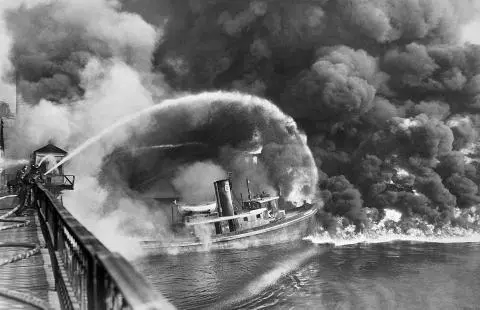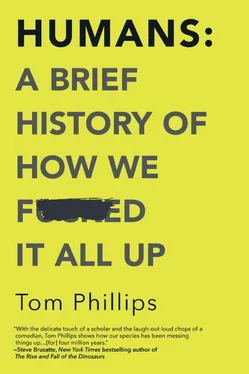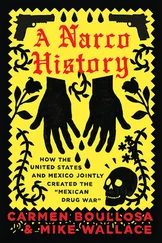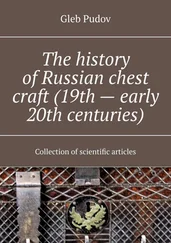Tom Phillips - Humans - A Brief History of How We F*cked It All Up
Здесь есть возможность читать онлайн «Tom Phillips - Humans - A Brief History of How We F*cked It All Up» весь текст электронной книги совершенно бесплатно (целиком полную версию без сокращений). В некоторых случаях можно слушать аудио, скачать через торрент в формате fb2 и присутствует краткое содержание. Город: Toronto, Год выпуска: 2019, ISBN: 2019, Издательство: Hanover Square Press, Жанр: История, Юмористические книги, на английском языке. Описание произведения, (предисловие) а так же отзывы посетителей доступны на портале библиотеки ЛибКат.
- Название:Humans: A Brief History of How We F*cked It All Up
- Автор:
- Издательство:Hanover Square Press
- Жанр:
- Год:2019
- Город:Toronto
- ISBN:978-1-48805-113-5
- Рейтинг книги:4 / 5. Голосов: 1
-
Избранное:Добавить в избранное
- Отзывы:
-
Ваша оценка:
- 80
- 1
- 2
- 3
- 4
- 5
Humans: A Brief History of How We F*cked It All Up: краткое содержание, описание и аннотация
Предлагаем к чтению аннотацию, описание, краткое содержание или предисловие (зависит от того, что написал сам автор книги «Humans: A Brief History of How We F*cked It All Up»). Если вы не нашли необходимую информацию о книге — напишите в комментариях, мы постараемся отыскать её.
Humans: A Brief History of How We F*cked It All Up — читать онлайн бесплатно полную книгу (весь текст) целиком
Ниже представлен текст книги, разбитый по страницам. Система сохранения места последней прочитанной страницы, позволяет с удобством читать онлайн бесплатно книгу «Humans: A Brief History of How We F*cked It All Up», без необходимости каждый раз заново искать на чём Вы остановились. Поставьте закладку, и сможете в любой момент перейти на страницу, на которой закончили чтение.
Интервал:
Закладка:
It’s not necessarily all over for the Aral Sea; recent (very expensive) efforts to divert some water back to it have led to a bit of an improvement in the small northern sea, with fish stocks gradually returning, although the southern sea is pretty much a write-off. But it still stands as a testament to our capacity for thinking we can just make large-scale changes to the geography of our environment without there being some sort of blowback.
Weirdly, this isn’t even the first time this has happened to one of the rivers involved. I’m not sure if there’s a world record for “most consistently diverted river,” but the Amu Darya has to be in with a shout. For centuries, interventions by both nature and a series of human regimes have repeatedly changed its course from flowing to the Aral Sea to the Caspian Sea (or sometimes both) and back again. In the second century CE it’s thought to have flowed into the desert, where it evaporated, before at some point switching to the Aral Sea. In the early thirteenth century, a particularly drastic intervention by the Mongol Empire changed its course again (more on that in a later chapter), sending at least part of it toward the Caspian, before it returned to the Aral Sea sometime before the 1600s. In the 1870s, long before the Soviet Union came into being, the Russian Empire gave serious consideration to diverting it back to the Caspian, on the grounds that they thought the fresh water was going to waste pouring into a salty lake. Which… is not how it works, guys.
It was agriculture that first led us to change the environment in dramatic ways, often with unforeseen consequences, but it’s not the only way we do that anymore. Agriculture has in many ways been outpaced by the rise of industry, and human beings’ apparently unquenchable desire to dump stuff we don’t want into the environment without really thinking about the consequences.
An example of those consequences would be the way that, late one morning on a warm summer’s day in 1969, the Cuyahoga River caught fire.
Rivers, to be clear, aren’t meant to do that. For any readers who are still vague on the general concept of rivers, they’re medium to large natural channels of flowing water, and water is not commonly regarded as being especially flammable. Rivers do an awful lot of things—transporting water from high ground to lowlands, providing a metaphor for the passage of time, forming oxbow lakes so children can at least remember something from their geography lessons—but bursting into flames is absolutely not supposed to be one of them.
The Cuyahoga River did, though, and what’s more it wasn’t the first time it had done it. Not even close. In fact, the Cuyahoga—which meanders slowly through industrial northern Ohio before bisecting the city of Cleveland and plopping into Lake Erie, and which was described by one nineteenth-century mayor of Cleveland as “an open sewer through the center of the city”—was so polluted that it had caught fire no fewer than 13 times in the previous 101 years. It burned in 1868, 1883, 1887, 1912 (when five men died in the resulting explosions), 1922 and 1930. In 1936, the fire was so bad that it raged for five days—which, to reiterate, is not traditional behavior for rivers. It burned again in 1941 and in 1948 and then most destructively in 1952, when the two-inch-thick slick of oil that lay across its surface lit up, sparking an enormous conflagration that destroyed a bridge and a shipyard and caused as much as $1.5 million worth of damage.
In comparison to 1952, the 1969 blaze was comparatively small stuff. Caused by the ignition of a coagulated mix of oil, industrial waste and debris that had combined to form a sort of flammable trashberg floating down the river, it put on an impressive show (the flames were five stories high) but was under control inside half an hour, the Cleveland fire department clearly being on top of their river-fire-extinguishing game by this point. The people of the city were apparently so used to this sort of stuff that the goddamn river catching fire only merited five paragraphs of story deep on the inside pages of the Cleveland Plain Dealer .
But if Cleveland’s long-suffering populace were kind of “oh, that again” about river fires by 1969, the nation as a whole was not. Things had changed since the last time the Cuyahoga burned. It was the sixties, after all, and society was being shaken to its core by a series of revolutionary new ideas, such as “having fewer wars,” “not being quite as racist” and “maybe trying not to fuck the planet up entirely.”
So when Time magazine cottoned on to the fire a few weeks later, they wrote it up in a story on the state of the nation’s rivers titled “America’s Sewage System and the Price of Optimism,” which included this memorable description of the Cuyahoga: “Chocolate-brown, oily, bubbling with subsurface gases, it oozes rather than flows… an open sewer filling Lake Erie with scummy wavelets.” Time ’s article grabbed the country’s attention and prompted widespread demands for change—largely thanks to the jaw-dropping picture that accompanied the story, a dramatic shot of a boat engulfed in the flames of the burning river as fire crews struggled to contain the blaze. Actually, that picture wasn’t of the 1969 fire; it was an archive photograph from the 1952 blaze, because the 1969 fire had been dealt with so quickly that it was out before any photographers or film crews managed to turn up. The picture hadn’t caught the national imagination back in 1952, but now it worked a treat. Sometimes timing is everything.

Since the 1800s, the industries of Ohio had been cheerfully spilling both the by-products and indeed the products of their work into the Cuyahoga. This led to regular bouts of the media, politicians and public saying things like, “Uh, maybe we should do something about this?” followed by nobody really doing anything about it. A few half-hearted measures were implemented in the years after the war, but they were mostly concerned with making the river safe for shipping rather than making the river not inherently flammable.
Still, it was perhaps slightly unfair that the Cuyahoga became the national symbol of humanity’s inaction in the face of environmental destruction, if only because the year before the fire, the city of Cleveland had actually passed some laws to finally get the river cleaned up. Quite a few local officials sounded a bit miffed at the fact that they had become the poster river for the filthy state of the nation’s waterways (to the extent that there were even songs written about it). “We were already doing the things we needed to clean up things there, and then the fire happened,” one said plaintively.
After all, theirs wasn’t even the only burning river in the country at the time. The Buffalo River caught fire in 1968, the year before Cuyahoga, while the Rouge River in Michigan burst into flames just a few months after it in October 1969. (“When you have a river that burns, for crying out loud, you have troubles,” the Detroit Free Press lamented in the aftermath.) Cuyahoga wasn’t even the only river in the US to have caught fire on multiple occasions—in the nineteenth century, the Chicago River saw conflagrations with enough regularity that the community would come out and watch like it was a Fourth of July display—although it definitely takes the prize for Most Consistently on Fire River, North American Category.
Still, the tale of the flaming river did its job, spurring national action. The nascent environmental movement, already primed by books like Rachel Carson’s 1962 work Silent Spring , began to coalesce (the first Earth Day was marked the following year). Congress was forced to take action, passing the Clean Water Act in 1972. Gradually the state of America’s waterways improved, to the point where they now hardly ever catch fire. In a rare example of a happy ending in this book, people actually did what they needed to do to make things better, and hahaha, there’s absolutely no chance that the Trump administration would ever attempt to overturn clean water standards because they’re worried industries aren’t allowed to pollute rivers enough. [Puts finger to ear.] Oh, I’m being told that’s exactly what they’ve done.
Читать дальшеИнтервал:
Закладка:
Похожие книги на «Humans: A Brief History of How We F*cked It All Up»
Представляем Вашему вниманию похожие книги на «Humans: A Brief History of How We F*cked It All Up» списком для выбора. Мы отобрали схожую по названию и смыслу литературу в надежде предоставить читателям больше вариантов отыскать новые, интересные, ещё непрочитанные произведения.
Обсуждение, отзывы о книге «Humans: A Brief History of How We F*cked It All Up» и просто собственные мнения читателей. Оставьте ваши комментарии, напишите, что Вы думаете о произведении, его смысле или главных героях. Укажите что конкретно понравилось, а что нет, и почему Вы так считаете.












